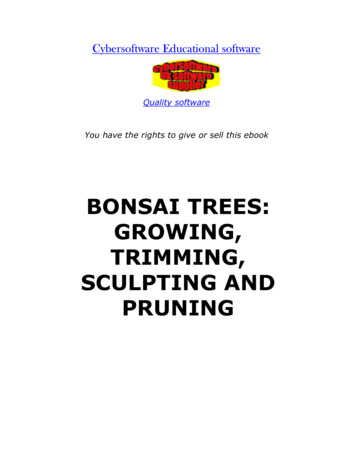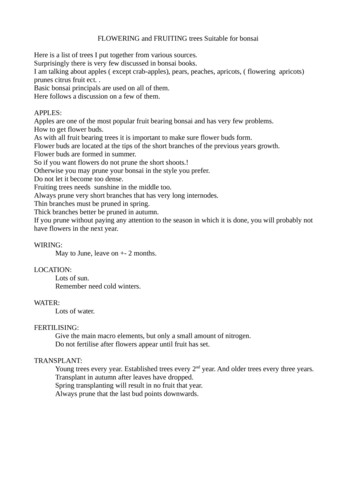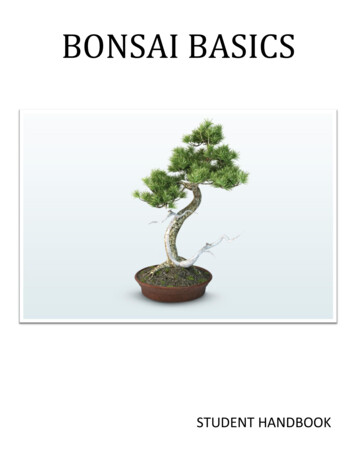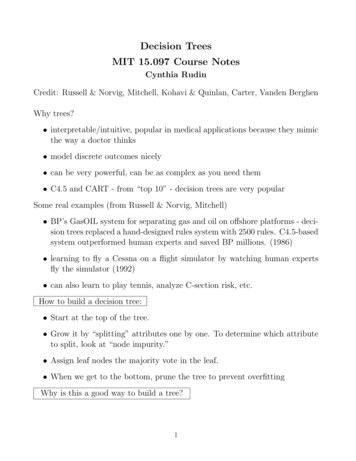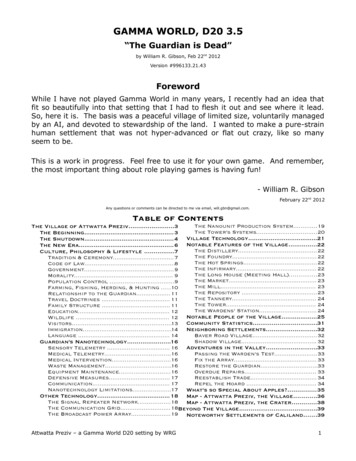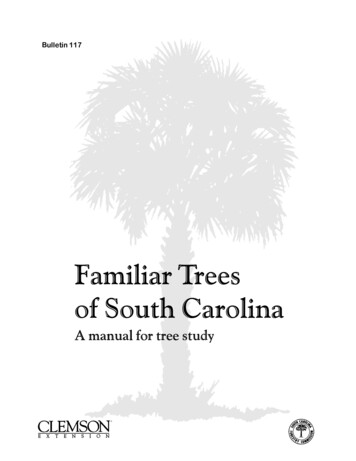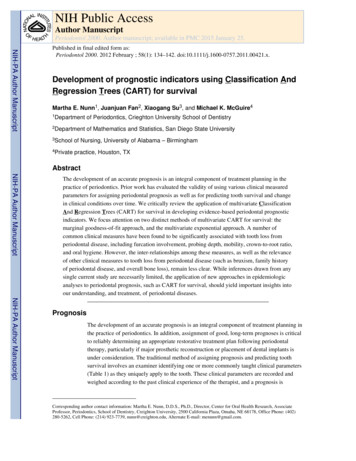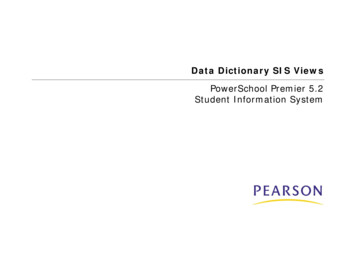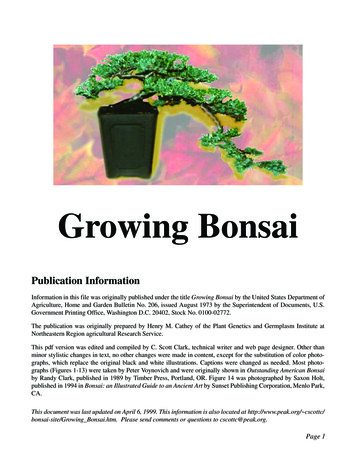
Transcription
Growing BonsaiPublication InformationInformation in this file was originally published under the title Growing Bonsai by the United States Department ofAgriculture, Home and Garden Bulletin No. 206, issued August 1973 by the Superintendent of Documents, U.S.Government Printing Office, Washington D.C. 20402, Stock No. 0100-02772.The publication was originally prepared by Henry M. Cathey of the Plant Genetics and Germplasm Institute atNortheastern Region agricultural Research Service.This pdf version was edited and compiled by C. Scott Clark, technical writer and web page designer. Other thanminor stylistic changes in text, no other changes were made in content, except for the substitution of color photographs, which replace the original black and white illustrations. Captions were changed as needed. Most photographs (Figures 1-13) were taken by Peter Voynovich and were originally shown in Outstanding American Bonsaiby Randy Clark, published in 1989 by Timber Press, Portland, OR. Figure 14 was photographed by Saxon Holt,published in 1994 in Bonsai: an Illustrated Guide to an Ancient Art by Sunset Publishing Corporation, Menlo Park,CA.This document was last updated on April 6, 1999. This information is also located at http://www.peak.org/ cscottc/bonsai-site/Growing Bonsai.htm. Please send comments or questions to cscottc@peak.org.Page 1
ContentsIntroduction . 3Principles of Bonsai . 3Choosing a Style. 4Basic Styles . 4Formal Upright . 5Informal Upright . 5Slanting . 6Cascade . 7Semi-Cascade . 7Plant Selection Guide . 8Trees and Shrubs . 8House Plants . 9Obtaining Plants . 10Collecting Plants from the Wild . 10Importing Mature Plants . 11Nursery Plants . 11Shaping Bonsai . 12Overall Design . 12Pruning. 13Nipping . 13Wiring . 14Containers for Bonsai . 14Training Pots . 14Choosing Pots . 15Potting . 15Repotting . 16Growth Media . 16Seasonal Care . 17Spring Care . 17Summer Care . 17Fall Care . 17Winter Care . 17Coldframes. 17Watering . 18Fertilizer. 18Propagating Bonsai . 18Seedlings . 18Cuttings . 18Layering . 19Grafting . 19Displaying Bonsai . 19Indoor Display . 19Bonsai in the Garden . 20Page 2
IntroductionBonsai are miniature trees grown in pots. The aim of bonsai culture is to develop a tiny tree that has all theelements of a large tree growing in a natural setting. This look is achieved, principally, by branch and rootpruning and shaping, but other factors are also important. The texture of the trunk, its look of age, the mossand the under plantings in the container — all contribute to the illusion of a miniature tree as it is seen innature.A presentable bonsai can be created in a few seasons. Cultivating these miniature potted trees is both anintriguing hobby, and a means of adapting a wide range of plants to specialized and decorative uses. Bonsairequire daily watering during their growing season, and, because the plants are rooted in shallow pots,careful pruning.Bonsai are kept outdoors most of the year, but — from time to time — these miniaturized versions of natureare brought indoors for display. Only certain tropical trees, shrubs, and vines can be continually kept indoors full time as bonsai.Bonsai, as an art form, stems from ancient oriental culture. It originated in China and was developed by theJapanese. In the 13th century, the Japanese collected and potted wild trees that had been dwarfed by nature.These naturally formed miniatures were the first bonsai.When demand for the small trees outstripped the supply, Japanese gardeners began to train bonsai fromnative trees. They shaped the trees to give them the illusion of age and naturalness. Over the years, theJapanese devised standards of shape and form, which gradually began the classic bonsai styles.American bonsai are much freer in concept and style than Japanese bonsai. American bonsai growershave recognized that the horticultural and aesthetic rules are important, but are specifically aimed atJapanese culture. Because of this, Americans have taken oriental styles and applied them to plants nevergrown by the Japanese. Therefore, the rigid procedures and names used by the Japanese are not used inthis bulletin.Principles of BonsaiNot all plants are equally effective as bonsai. To produce a realistic illusion of a mature tree, look for plantswith the following characteristics:····Small leaves or needles.Short internodes, or distances between leaves.Attractive bark or roots.Branching characteristics for good twig forms.All parts of the ideal bonsai — trunk, branches, twigs, leaves, flowers, fruits, buds, roots — should be inperfect scale with the size of the tree. Plants used for bonsai should have small leaves, or leaves thatbecome small under bonsai culture. Plants with overly large leaves, such as the avocado, will look out ofPage 3
proportion if chosen for bonsai. Sycamores also develop leaves that are too large. Certain species of bothmaple and oak trees usually respond well to bonsai culture and develop leaves that are in proportion.Among the plants with small leaves and needles are spruce, pine, zelkova, pomegranate, and certain oaksand maples.Plants chosen for bonsai should have attractive bark, and the trunk must give the illusion of maturity. Thetrunk should have girth, but must remain in proportion to the entire tree. The trunk should taper graduallytoward the top of the tree. Sometimes one or two of the main branches must be shortened to emphasize thevertical line of the trunk and give the trunk a balanced appearance.To give the appearance of age, the upper one-third of the root structure of a mature bonsai is often exposed.This is especially effective if the roots have good girth and form. Twisted and tangled roots should bestraightened before potting or repotting a tree to achieve an aged appearance. Bonsai from nursery stock,and trees collected from the wild, should have a root system that will — when exposed — add to theappearance of the finished bonsai.Plants have a “best profile” just as people do. Decide on the front of the tree at the very beginning, becauseplanting and shaping are done with the front of the tree in mind. However, you may change your ideasabout the plants ultimate shape as you clip and prune.The front of the bonsai should offer a good view of the main trunk, which must be clearly visible from thebase to the first branch, typically about one-third the way up. Everywhere on the tree, but mostly from thefront, the branches should look balanced and appear to be floating in space; they should not appear lopsided or top-heavy. The branches should not be opposite one another with their lines cutting horizontallyacross the trunk. The branches give the bonsai the dimension and establish the tree’s basic form.A bonsai should have a harmonious arrangement of branches without unsightly gaps. Flaws can be spottedby looking down on a bonsai. Upper branches should not overshadow lower branches.Before deciding on the shape of your bonsai, study the tree carefully, and take into account the natural formof the species. Observe the way mature trees of the same kind grow in their natural setting to achieve animpression of age and reality.Decide on the final shape and size of your bonsai before starting. Make a rough sketch of what you wish tocreate and use it as a guide.Choosing a StyleBasic StylesBonsai can be classified into five basic styles: formal upright, informal upright, slanting, cascade, andsemi-cascade. These classifications are based on the overall shape of the tree and how much the trunkslants away from an imaginary vertical axis.The numerous Japanese bonsai styles are principally variations of these five basic styles. The styles givenin this bulletin apply to trees with single trunks. The single trunk style is the basic design that is simplest toshape because the one trunk determines the overall composition.Page 4
Formal UprightThe formal upright style has classic proportions and is thebasis of all bonsai. It is the easiest for a beginner to developbecause it requires the least experimentation, avoids the problem of selective pruning, and should almost immediatelybecome a displayable bonsai.In this style, the form is conical or sometimes rounded andthe tree has an erect leader and horizontal branches. One ofthe branches is lower and extends a little farther from thetrunk than the others (Figure 1). Also, the lowest two branchesare trained to come forward on the front side of the tree, oneslightly higher than the ot
Growing Bonsai Publication Information Information in this file was originally published under the title Growing Bonsai by the United States Department of Agriculture, Home and Garden Bulletin No. 206, issued August 1973 by the Superintendent of Documents, U.S. Government Printing Office, Washington D.C. 20402, Stock No. 0100-02772. The publication was originally prepared by Henry M. Cathey of .
